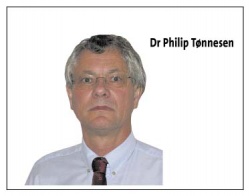Facing the future
by Dr Philip Tønnesen (Dr Med. Science)
Increase in COPD and chronic respiratory disease patients will challenge the European Healthcare Systems in the future.

Dr. Philip Tønnesen, Chair of the pulmonary medicine department at Gentofte University Hospital, Copenhagen, Denmark; President of the Danish Respiratory Society and Vice-Chair of the European Respiratory Society Annual Congress 2005 (17-21 September) about the development of respiratory diseases.
Respiratory diseases have an important negative impact on morbidity and mortality and this impact appears to be increasing, mainly due to smoking-induced disorders such as COPD and lung cancer. Also, during the last decade, and mainly in western Europe, an increasing incidence of asthma patients has appeared.
During coming decades we will have to deal with an increase in COPD patients as well as patients with other chronic diseases, and patients in the future will demand far more of us, all of which will challenge healthcare systems in many ways. Co-operation between hospitals, general practitioners and primary healthcare groups must be optimised, harmonized and we need to use similar clinical guidelines. Prompt exchange of patient health information’s calls for fast implementation of the electronic patient record (EPR) and in a few years it will probably be customary, during discharge from hospital, for a patient to have personal health information downloaded on to his or her own pocket computer. The EPR will be a very big step forward in terms of the availability of health information and quality control.
In hospitals, an increasing burden will be more COPD patients of greater age. Until now the monitoring of acute admitted COPD patients have been relative sparse and in many departments not optimal. A simple comparison can be done with patients with acute myocardial infarction and in fact the mortality is as high in patients admitted with COPD. There is a need to increase the quality of monitoring of COPD patients and other patients with acute respiratory distress. In the next decade continuous monitoring of oxygen, carbon dioxide, respiratory rate, etc. should be standard during the first days of hospitalisation and easier ways to assess pH is strongly wanted.
Non-invasive ventilation (NIV) will also be standard in all departments who receive acute COPD patients and this therapy will not only decrease acute mortality but also increase the prestige of respiratory medicine among our colleagues in internal medicine.
New studies will show whether long-term home NIV will be effective or the use of NIV should be used to prevent exacerbations in COPD.
Long-term oxygen treatment (LTOT) will be demanded by many more COPD patients than today, and our role will be to prescribe oxygen according to clinical guidelines. Ambulatory oxygen will have an increasing use and further development of lightweight portable oxygen with long duration will be demanded.
In the next decade, I suspect a dramatic increase in the quality of care for patients with respiratory diseases and a demand for more optimal monitoring and treatment equipment.
Last but not least, we must not forget that smoking cessation is of major importance to prevent COPD and lung cancer.
03.08.2006




